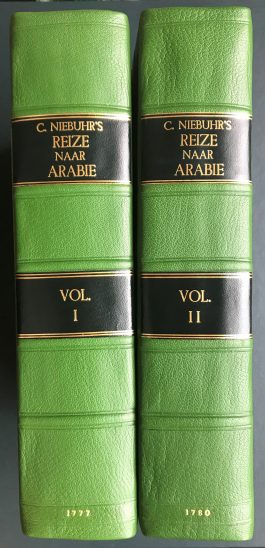Reize naar Arabië en Andere Omliggende Landen. TWO VOLUMES.
Niebuhr, Carsten.
Synopsis
This first Dutch edition of Niebuhr’s travels to the East. Carston Niebuhr (1733-1815), a German mathematician, cartographer, and explorer in the service of Denmark, is renowned for his participation in the Royal Danish Arabia Expedition.
The famous account of the Royal Danish expedition (1761-67) to Constantinople, Egypt, Sinai, the Arabian Peninsula, Iraq and Persia. It was the first scientific expedition to that areas sponsored by King Frederick V of Denmark, and from which Niebuhr returned as the only survivor. The expedition faced continuous physical hardship and danger from the moment it failed to leave Danish waters against winter storms, until the loss of all its members, except Niebuhr, as a result of malaria in Yemen. Nonetheless, the scientific discoveries that were made and the array of manuscripts that were recovered, aroused lasting interest among Europeans, curious to hear about a part of Arabia that had previously been closed off.
The plates include illustrations of food, shoes, clothing, inscriptions, coins, agriculture, military exercises in the Yemen, the mosques of Mecca and Medina, and maps of Oman, the Arab Gulf, Suez and the Red Sea. Niebuhr was famous for his map of the Yemen (55 x 35 cm) which he calculated by traversing the country and measuring the distances mile by mile. It was the map of the Red Sea that contributed to the British in India re-routing their cargoes via the Suez instead of around Africa. For the next century this map served further European explorers of Arabia. His map of the Arab Gulf is the earliest map to mention Kuwait. Niebuhr is also one of the first to call the country Yemen instead of Arabia Felix.
His work still forms one of the most authoritative descriptions of Arabia and in particular Yemen. The first edition appeared in German in Copenhagen in 1772, and then this Edition in Dutch, soon after, the French Edition – The second French version is by an anonymous translator. “He was the first European to mention the spread of the Wahhabi revolution, an Islamic fundamentalist movement which had a tremendous influence on the history of Arabia” (Waldman, 1992).
Bibliographic references: Brunet IV, 74; Cox I, 237; Gay 3389; Lipperheide Lc 6.






